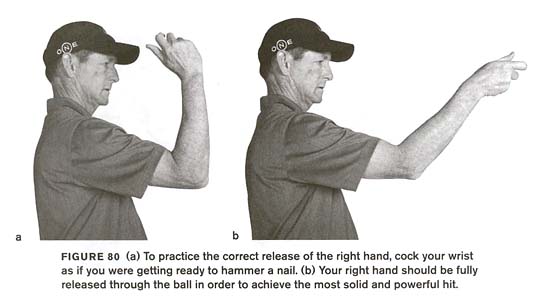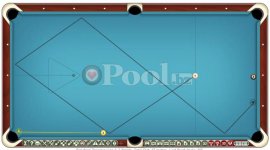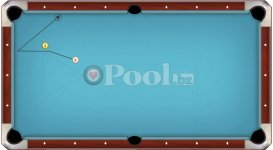The link works for me. Well the first one. Have no idea what the second one is. HTML or something. Sorry, I wish I knew how to post the picture like other people do. Does the first link work? Basically place a ball on the rail 3 diamonds from the foot. Place the cue on the head spot dot. You have to cut the ball on the rail in the bottom corner. Make the cue go to the bottom rail and two or three rails to the top rail for position on the 8. I found many players could get the cue ball to the bottom rail.
You are using an out of date browser. It may not display this or other websites correctly.
You should upgrade or use an alternative browser.
You should upgrade or use an alternative browser.
Great stroke
- Thread starter jburkm002
- Start date
Got it. For my stroke 2:30 on the cue ball
I am hitting the foot rail about a diamond inside of the corner pocket, carrying up to the second diamond on the long rail on the side of the one ball and carrying down to foot rail.
I am hitting the foot rail about a diamond inside of the corner pocket, carrying up to the second diamond on the long rail on the side of the one ball and carrying down to foot rail.
Hope this works.
All the cb knows is where it was hit, what speed it was hit at, and what angle it was hit at. Each individual combination will produce the exact same results each time it is performed.
The simple truth. Impossible for some to understand.
Remember earlier I said this would go like a "aiming thread".
I prefer a simple draw shot. Same English, but try it with 1/2" follow through, then 3", then 6". Hit exact same speed.
Watch how this "useless" thing multiplies the spin on the CB.
It's not that it alters the contact time b/w tip and CB (though it could if you're a really bad stabber), it's that it significantly alters what the tip is doing while in contact. It generally makes the contact look just like your practice strokes, avoids "steering" and prevents stabby, jerky movements in your stroke.
A slip stroke is an almost ideal cue delivery (since it's sliding in a straight line with no arm movement at all). You get the same results with a 6" follow through, and it's more controllable.
Watch how this "useless" thing multiplies the spin on the CB.
It's not that it alters the contact time b/w tip and CB (though it could if you're a really bad stabber), it's that it significantly alters what the tip is doing while in contact. It generally makes the contact look just like your practice strokes, avoids "steering" and prevents stabby, jerky movements in your stroke.
A slip stroke is an almost ideal cue delivery (since it's sliding in a straight line with no arm movement at all). You get the same results with a 6" follow through, and it's more controllable.
Unless you are choking up on your cue and changing your bridge hand distance from the CB you are going to have trouble hitting each of these with exactly the same speed.
I prefer a simple draw shot. Same English, but try it with 1/2" follow through, then 3", then 6". Hit exact same speed.
Watch how this "useless" thing multiplies the spin on the CB.
It's not that it alters the contact time b/w tip and CB (though it could if you're a really bad stabber), it's that it significantly alters what the tip is doing while in contact. It generally makes the contact look just like your practice strokes, avoids "steering" and prevents stabby, jerky movements in your stroke.
A slip stroke is an almost ideal cue delivery (since it's sliding in a straight line with no arm movement at all). You get the same results with a 6" follow through, and it's more controllable.
I have to disagree. Try that shot and see how it turns out.
I am an A player. Do you really think I have never executed that shot before? Seems like you are looking for some "magical" stroke that doesn't exist or is super-human or something. Balls can only follow physics, nothing more.
For what it's worth, I just did it on a barbox. Much steeper angles on the smaller table. Just hit the cb at 2:30 as far out as you can. Those that can't hit the bottom rail are hitting rail first, then the ob. You have to hit both at the same time to avoid the carom off the rail killing the forward spin. You also want as much spin as you can generate, but not a lot of forward speed. The spin is what carries the cb around the table.
edit: And, that was with a 314 shaft. Shots like that are easier with a high deflection shaft because you can deflect the cb more and come in straighter on the ob.
Last edited:
I prefer a simple draw shot. Same English, but try it with 1/2" follow through, then 3", then 6". Hit exact same speed.
Watch how this "useless" thing multiplies the spin on the CB.
It's not that it alters the contact time b/w tip and CB (though it could if you're a really bad stabber), it's that it significantly alters what the tip is doing while in contact. It generally makes the contact look just like your practice strokes, avoids "steering" and prevents stabby, jerky movements in your stroke.
A slip stroke is an almost ideal cue delivery (since it's sliding in a straight line with no arm movement at all). You get the same results with a 6" follow through, and it's more controllable.
I really suggest you take some Sat. and just go through Dr. Dave's website. Much for you to learn there.
Unless you are choking up on your cue and changing your bridge hand distance from the CB you are going to have trouble hitting each of these with exactly the same speed.
Yeah, that takes practice. It's extremely to get lots of follow through on softer shots.
I really suggest you take some Sat. and just go through Dr. Dave's website. Much for you to learn there.
I've been following those videos for nearly a decade now. His videos would only be relevant here if he were showing how the stroke mechanics change as you change follow through.
If you think changing your follow through won't change your stroke mechanics, based on high speed vids of tips hitting balls, you are sorely misinterpreting Dr. Dave's results.
No I am not trying to say it's some magical shot. Never implied that. However I am guessing some may have a hard time with that shot as I have seen others have. How did you apply english? you said at 230 right but how did you apply that english. There are different ways to apply English that can have different results. Like playing high right. Try high right with backhand English and Parallel english. Do you get the same result. You an A player. Surely you understand this but others may not. So saying used 230 doesn't mean much. That's where you aimed but not how. There is a difference in the how. Whole point of the thread to a degree.
Sent from my SCH-I545 using Tapatalk
Sent from my SCH-I545 using Tapatalk
It's all in the Hands/Wrists/Fingers
It's all in the hands....understanding how to utilize the wrists/hands/fingers to generate cue speed is essential to a "good stoke". It's NOT done the way that is commonly taught, it's more like the motion of using a hammer, or casing a rod and reel.

It's all in the hands....understanding how to utilize the wrists/hands/fingers to generate cue speed is essential to a "good stoke". It's NOT done the way that is commonly taught, it's more like the motion of using a hammer, or casing a rod and reel.

Some guys just have great strokes. They move the cue around effortlessly. Draw shots with little effort. Not all players have the same results even though we apparently are stroking the same way. There is even a separation amongst pros. It kinda like boxers. Two guys are the same weight and size but one just has knock out power. Even though both boxers look to be punching the same. What separates a great stroke from a good stroke? It's not a power thing. Is it their grip, bridge? Could it have something to do with where their grip hand is at when the cue ball is struck?
It's all in the hands....understanding how to utilize the wrists/hands/fingers to generate cue speed is essential to a "good stoke". It's NOT done the way that is commonly taught, it's more like the motion of using a hammer, or casing a rod and reel.

Oh, it's not, huh? Yes, you can use your wrist, but it is totally unnecessary to do so. It is NOT, and I repeat, NOT essential to a good stroke. It is a choice. It actually is totally unnecessary to employ the wrist. If you like to do things the hard way, have at it. But don't expect people that know better to buy that nonsense.
No I am not trying to say it's some magical shot. Never implied that. However I am guessing some may have a hard time with that shot as I have seen others have. How did you apply english? you said at 230 right but how did you apply that english. There are different ways to apply English that can have different results. Like playing high right. Try high right with backhand English and Parallel english. Do you get the same result. You an A player. Surely you understand this but others may not. So saying used 230 doesn't mean much. That's where you aimed but not how. There is a difference in the how. Whole point of the thread to a degree.
Sent from my SCH-I545 using Tapatalk
I assume you understand that using backhand english and parallel english, you are coming at the cb from two different angles, and therefore will get different results. Do you understand WHY you get different results? And what you have to do differently when using each one? For the record, I used parallel english for the shot. I used parallel english because I used a low deflection shaft and using parallel aided the shot. Do you know why it aided the shot?
I've been following those videos for nearly a decade now. His videos would only be relevant here if he were showing how the stroke mechanics change as you change follow through.
If you think changing your follow through won't change your stroke mechanics, based on high speed vids of tips hitting balls, you are sorely misinterpreting Dr. Dave's results.
It seems you have seen the forest, but totally missed the trees in it.
Your follow through should be nothing more than a natural stopping of your cue. So, if your follow through is longer, that means that you hit the shot harder. You changed your stroke mechanics by adding speed. Hence, you did not hit the shot the same way each time.
It seems you have seen the forest, but totally missed the trees in it.
Your follow through should be nothing more than a natural stopping of your cue. So, if your follow through is longer, that means that you hit the shot harder. You changed your stroke mechanics by adding speed. Hence, you did not hit the shot the same way each time.
You can argue all you want, but you seem to miss the fact that I'm correct by definition. Follow through is part of the stroke mechanics, so obviously it changes the stroke mechanics if you change that. Duh.
You can indeed hit them the same speed. Without intentional follow through, them tendency is to not naturally stop your stroke as you say, but to stop it with your muscles, as a reaction to feeling the hit. This causes bad things. If you continue the motion through the ball, you don't have these trained muscle reactions to the actual hit, and just smoothly deliver the cue.
So you can intentionally stop the cue at hit, my first example (not what anyone would call a "good stroke"), continue the motion 3" afterwards, or 6" afterwards all while moving the stick the same speed.
I'm not talking about natural deceleration here, because that's not what normally happens in any case. With the cue being connected to your arm, the weight of the ball isn't enough to completely stop the stroke motion, even at huge break speeds. You always stop your arm, not the impact.
Not sure what your issue is with me Neil. Your a good player. You understand the benefits of applying english differently. However someone watching you play may see you make that shot and think well he must just have a great stroke. They try to duplicate that shot and can't. They try and try and can't do it. Why because they might not know any better. They don't know you may have HAD to play parallel english to make a certain shot for position or avoid a ball. They might not even know what parallel english is. Some players think high right is high right as I did for many years. Just thought it was a helpful shot for players to test their stroke and understanding of english.

